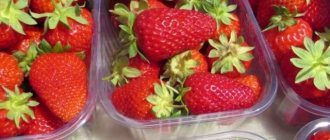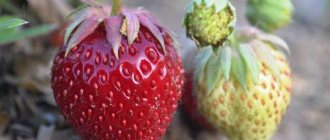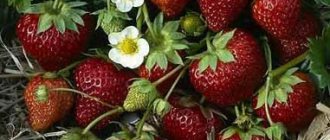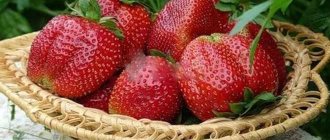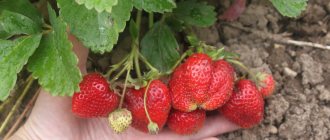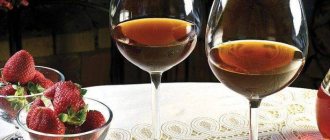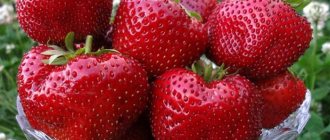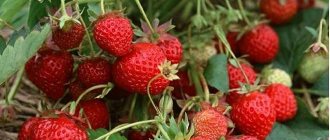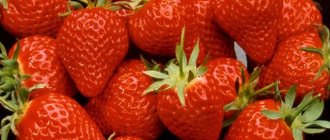Strawberry Malvina is a late-ripening German garden strawberry. Malvina was bred in 1998, but appeared on the Russian market relatively recently, in 2010. The variety was developed by the German breeder Peter Stoppel. To obtain Malvina, the following varieties had to be crossed:
- Sophie.
- Schimmelpfeng clone.
In 2014, the variety was included in the State Register of Ukraine; it was not included in the State Register of the Russian Federation.
In this publication we will introduce you to the amazing German strawberry Malvina. Let's present a description of the variety, show its photos and reviews of gardeners who were lucky enough to grow this interesting strawberry on their plot.
History of the strawberry variety Malvina
Both adults and children love sweet and fragrant strawberries. Therefore, many summer residents try to follow fashion trends on the market. So, for those who want to keep up with the achievements of selection in this direction, we present - Malvina strawberries. The variety is new, it appeared on the market in 2010, but is already attracting the attention of connoisseurs.
Malvina is the result of hybridization of the Sophie variety and a clone from Schimmelpfeng and Weihenstefan. The author was the German breeder Peter Stoppel.
Strawberry Malvina sets records for late fruiting among modern varieties - the latest
Reviews
Based on reviews from gardeners and ordinary consumers, Malvina is a worthy variety that is very popular.
The long-awaited Malvina is coming.
In some cases, it surpasses in quality many generally recognized elite species. Despite the fact that it ripens quite late, it requires a special approach due to its rapid growth.
- Many people note that strawberries are much tastier than Pandora, Argentra, and Tago.
- It is also resistant to temperature changes.
- Maximum adaptive abilities and mass fruiting are recorded.
- No reaction to rainy weather - taste and smell do not change during prolonged rains.
- In extreme heat, the berries do not bake; due to their dense consistency, they do not leak during transportation.
Some gardeners consider late fruiting to be an advantage due to the fact that, in this way, the strawberry conveyor is not disrupted - only the berries have run out - Malvina has ripened. Convenience in culinary processing is noted - canned food, jam, yoghurts, cocktails, smoothies.
Description of the variety
Reaching 50 cm in height and 40–50 cm in diameter, Malvina bushes look strong and powerful. The variety is multi-horned - one plant produces from 5 to 8 pedicels, each of which can contain up to 6 bisexual flowers. The leaves are large, with a shiny surface, dark green in color, located horizontally to the surface of the ground, preventing rapid drying out of the soil in hot weather. Beneath them are flower stalks.
The plant blooms in early June, and fruiting occurs in the last quarter of June.
On average, the weight of the berries ranges from 35 to 45 g; individual specimens can grow up to 80 g. The fruits are bright and attractive, deep red in color, with a shiny glossy surface. A well-ripened berry will have a cherry hue. The shape of the fruit resembles a shortened cone with a relief surface.
The consistency of Malvina pulp is very dense, but juicy. The variety is classified as a dessert variety due to the high sugar content in the berries. The aroma is bright and pleasant.
Tasters highly appreciate the sweet taste of strawberries - 4.6 points out of 5 possible.
Characteristics of the variety
With proper care, 0.5–1 kg of fruits are collected from one bush. Having a dense consistency and durable skin, the berry can easily withstand long-term transportation, which allows it to be grown for sale.
Malvina is a late-ripening variety; the first fruits can be tasted at the end of June. The fruiting period lasts until mid-July.
The ripening period of the berry is influenced not only by weather conditions, but also by the age of the plant: the older the bush, the later it bears fruit.
Thanks to its bisexual flowers, the variety does not require pollinators. Therefore, even in windy and rainy weather, when pollinating insects are rare guests in the garden, the harvest will ripen on time. During the period of damp and rainy weather, when the berries of most varieties begin to deteriorate, Malvina does not lose its taste.
The frost resistance of the variety is quite good - down to -19°C. In the southern regions, in the absence of snow cover, the variety tolerates winter well. It also grows well in central Russia, but under covering material.
The variety shows good immunity to powdery mildew and gray rot. But it is susceptible to fusarium and verticillium, as well as to weevils and thrips.
Reviews from experienced gardeners and photos
The Malvina variety has received mostly positive reviews. Gardeners really like the sweet dessert taste of the berries, their size, and are also attracted by the fact that this is a late variety. Strawberries do not require special care, easily tolerate both heat and cold, and rain, and are rarely susceptible to diseases and pest attacks. The bushes take root easily and, thanks to the large number of tendrils, reproduce.
One of the disadvantages is the need for space. For this reason, it is problematic to plant it in small summer cottages. In addition, the yield level does not always meet expectations.
How to plant Malvina strawberries correctly
Tall and powerful bushes require a special planting scheme. Strawberries do not tolerate thickening, so you need to try to allocate as much space as possible for them.
Site selection
To plant strawberries, choose a flat, well-lit area protected from the wind, possibly on a slight slope. The beds should be located from north to south or southwest.
The area for strawberries should be level, well lit and located in a place protected from the wind.
Loose, cultivated and weed-free soil is suitable for strawberries. Malvina will produce good harvests on loams, chernozems and sandstones.
The following areas are not suitable for a strawberry bed:
- in the shade, under the crowns of mature trees - the harvest will be small, the berries will be small;
- in the lowlands - the accumulation of cold air can delay the ripening of the crop by 10 days;
- on steep slopes - the soil dries out too quickly and the soil is washed away. Exposure of the root system is unfavorable for the development of strawberries;
- with groundwater lying above 70 cm to the surface - during the period of snow melting, the roots will be flooded and the plant will die;
- with sandy soils - in such areas strawberries will not have enough water and nutrients.
The Malvina variety is grown in one place for up to 5 years. You can alternate planting berries with:
- legumes;
- greens;
- root vegetables (beets, carrots, radishes, turnips, radishes);
- cabbage;
- flowers (marigolds or bulbs, for example, daffodils, tulips).
It is not recommended to plant strawberries after:
- pumpkins;
- zucchini;
- cucumbers;
- watermelons and melons;
- tomatoes.
Potatoes especially inhibit strawberry plantings due to specific root secretions.
Selection of seedlings
Choose well-formed and vigorous plants with 3 to 5 leaves. Weak bushes are more susceptible to disease and have low yields. Healthy seedlings must meet the following requirements:
- the roots are light, fibrous, 5–7 cm long. The dark color of the root system indicates the age or disease of the specimen;
- the leaves should be bright green, without signs of damage;
- the central bud shows no signs of rot or exposure to parasites.
When buying seedlings, you should pay attention to the heart - it should be without signs of damage by diseases and pests
Site preparation
Prepare a bed for strawberries in advance: if you plant in the fall, then at the end of summer, if in the spring, then dig up and apply fertilizer in September. This is necessary for the soil to settle and become structured after processing.
- The site is dug as deep as possible, about 20–30 cm. Strawberries do not tolerate high concentrations of salts in the soil, so it is advisable to apply fertilizers during soil preparation, and not when planting in holes. This way the nutrients will dissolve and be more easily absorbed by the plant.
- Per 1 m2 of plot with loamy soils, add 1 bucket of well-rotted manure or compost for digging. Instead of organics, you can use nitroammophoska or nitrophoska - 2 tbsp. l. per 1 m2.
- In sandy soils, add up to 3 buckets of rotted manure or compost per 1 m2; you can add sawdust.
- To make heavy clay soils loose, be sure to add 3–4 kg of river sand and 2–3 buckets of organic matter (per 1 m2 of land).
The soil should be neutral or slightly acidic. At pH levels below 5.5, liming is carried out with dolomite flour. The application rate is 4 kg per 1 m2. Valid for up to 4 years, that is, during the period of growing strawberries in this area, the procedure is carried out once.
To give sandy soil the desired structure, sawdust is added to digging along with organic matter.
Landing dates
Summer planting is not recommended for Malvina; spring planting is considered more promising. Malvina strawberries bear fruit late; they can be planted only after the plant has set buds, at the end of August or September. But if early cold weather sets in, the seedlings may not take root and freeze.
Spring planting dates vary depending on the region. In the southern regions, strawberries are planted in mid or late April, in the middle zone - in early May.
According to many experienced summer residents, spring is the best time to plant Malvina
Planting Malvina strawberries in a few steps
Planting is carried out on cloudy days or in the evening. If you plant seedlings in the sun, moisture will evaporate greatly and unrooted bushes will die.
To mark the rows, use a taut rope to ensure the bed is level.
Before planting, overgrown roots need to be shortened to 5–7 cm, then dipped in clay mash (clay mixed with mullein and water until creamy).
The standard scheme for planting strawberries of this variety is not suitable. Tall bushes require more free space so that everyone gets the right amount of sunlight. With the most popular two-line planting (in two rows along the edges of the bed), the distance between the bushes is maintained at 50 cm; between rows - 70 cm.
How to plant strawberries:
- Dig holes measuring 25x25 cm at a measured distance.
- Water them well and lower the seedlings vertically into the hole. Avoid bending or twisting the roots.
- The heart should be strictly at ground level. Deepening will lead to rotting, and high planting will lead to drying out.
After planting, the strawberry heart should be level with the ground.
- Lightly compact the soil around the bush.
- Water the seedlings again, but not at the root, but around the plant. After absorbing moisture, mulch the surface of the ground.
The first harvest will not be abundant, but the next year the strawberries will produce more fruit.
Planting strawberries on agrofibre - video
Rules for caring for plantings
When performing agricultural work, it is better to take into account the characteristics of a particular variety, because each of them requires individual care. It is important to understand what you want to get: if there is a good harvest, you need to cut off all the strawberry tendrils; if there are seedlings, you need to sacrifice the harvest.
Watering
For normal rooting and development of strawberry seedlings planted in spring, almost daily watering is required in summer. But they need to be done in the evening so that drops of water falling on the leaves do not cause a burn.
If planting was carried out in the fall, the bushes begin to be watered with the onset of the growing season - at the end of April. Until summer, water once a week (30 liters per 1 m2). From June to early autumn, the frequency increases to 2 times a week, but precipitation should also be taken into account.
Recent Entries
5 working ways to use tar in the garden 7 indoor plants that help you get married even in adulthood Indoor plants that can bloom in trouble
Watering must be carried out:
- at the moment of formation of ovaries;
- when the berries are filled and there is abundant fruiting;
- during the formation of flower buds of the future harvest.
Malvina can withstand short-term droughts, but if there is insufficient moisture, the berry will become bitter and will be smaller in size.
If possible, give preference to drip irrigation of strawberries
Top dressing
Feeding should be done regularly:
- At the beginning of foliage growth, it is necessary to add nitrogen to the soil, which will ensure the formation of berries. To do this, you can use a solution of ammonium nitrate, which is applied by the foliar method (15 g per 1 m2). A good fertilizer option is 10 g of urea per 1 m2 of soil, as well as a solution of bird droppings (1:50) or cow manure (1:10).
- During the flowering period of strawberries, apply 15–20 g (per 1 m2) of complex mineral fertilizers with a high content of phosphorus, nitrogen, and potassium.
- After picking the berries, in order for strong fruit buds to form, a third feeding is carried out: 15–20 g of sodium chloride or superphosphate is applied per 1 m2 of soil.
- Feeding strawberries with superphosphate will improve the taste of the fruit. It is recommended to apply fertilizer 3-4 times per season. The most effective solution is considered to be a solution of cow manure (1:6), ash (1 glass per 10 liters of water) and 40 g of superphosphate.
As a dry fertilizer, you can add ash, which replaces superphosphate. It is scattered along the rows: once in the spring, with mulching of the soil, and again after fruiting and pruning the bushes. You can make an infusion and water the beds with it as a liquid fertilizer. For the solution, take 1 glass of ash and pour 1 liter of boiling water. Leave for a day, filter and add another 9 liters of water. To water 1 m2, 1 liter of mixture is enough.
Organic solutions - essential nutrition to increase strawberry yields
Loosening and weeding
To maintain cleanliness in strawberry plantings, be sure to weed. In this way, you will not only rid the plant of competitors for food and moisture, but also allow the bushes to receive enough lighting. Weed carefully so as not to damage the shallow roots. Weeds that have grown into the bush must be carefully trimmed with scissors.
Loosening and weeding help keep strawberry plantings clean
A day after watering or rain, loosening should be done. It improves heat and gas exchange in the soil and significantly reduces the rate of evaporation of the liquid necessary to moisten the roots.
When the process of ovary formation begins, loosening stops and mulch is poured onto the strawberry bed.
Mulching
Mulching is a great way to eliminate the need to frequently weed and loosen plantings. It slows down the growth of weeds and reduces moisture evaporation after watering. The benefit is that the berry lying on the substrate dries quickly and remains clean even after heavy rain.
Many summer residents use black film as mulch, but it does not allow air to pass through, and the strawberry roots rot, forming pathogenic microflora.
Mulch slows down the growth of weeds and reduces moisture evaporation after watering
Caring for strawberries after fruiting
After harvesting the last berries:
- Weed (very carefully) the beds of weeds, remove unnecessary tendrils, cut off old leaves;
- collect dried leaves from the ground, in which disease spreaders and pests live;
- fertilize with phosphorus-potassium fertilizers and treat the bushes against parasites.
These simple techniques will help strawberries prepare for winter and survive it safely.
Autumn strawberry care involves removing dried leaves
Winter shelter
Malvina tolerates frosts well if there is natural shelter in the form of snow cover. But in regions with an unstable climate, where frosts give way to thaws, then a drop in temperature again, you need to take care of how to insulate the strawberry beds.
A thick layer of mulch made from dry grass, straw, corn leaves, sawdust, spruce branches or pine needles will protect the plantings well. If the site is in an open area, agrofibre or a greenhouse on arcs will be suitable.
You can cover strawberries for the winter with pine or spruce branches.
Each method of protection has its own disadvantages. Field mice can live in the straw; they will certainly spoil the strawberry roots, and the pine needles greatly acidify the soil.
In the southern regions, where winters have little snow but are quite mild, the issue of covering material for strawberries is not so pressing - Malvina will be able to survive the winter in open ground.
Strawberry propagation methods
Since plants of the Malvina variety produce a lot of runners, they are propagated by runners. 5 mustaches are left on the mother bush, and the rest are cut off. The formed rosettes closest to the plant are the largest; the second and third rosettes are also suitable for propagation.
First, several of the most powerful plants are selected, their flower stalks are cut off, then they will grow good mustaches with rosettes. The roots of the rosettes should be sprinkled with moistened soil. The bushes are watered 2-3 times a week in hot weather, and the soil is loosened during rainfalls. 2 weeks after harvesting, the young rosettes on the tendrils are fully formed and have good roots. They are separated and transplanted.
Diseases and pests of Malvina strawberries
The Malvina variety is considered resistant to diseases, but there is always a risk of being affected by one or another of them.
Diseases and pests of Malvina strawberries - table
| Diseases and pests | Symptoms | Control measures | Prevention |
| Verticillium | A fungal disease develops in the soil. The main symptom is dried lower leaves. The bush develops poorly, the petioles acquire a reddish tint. The root system becomes loose and changes color. The berries become rotten. The bush dies 2–3 years after infection. | The following fungicides are used to combat the disease:
|
|
| Fusarium | The first signs appear in the form of reddish spots on the leaves. Whiskers and shoots turn brown. The leaves curl inward and the ovary ceases to form. The bush seems to settle. After 1–1.5 months the plant dies. | The area is treated with one of the following drugs:
If the bushes had to be removed, the soil under them is watered with Nitrafen. All drugs are used in accordance with the instructions. |
|
| Brown spot | Appears as brownish-brown spots on both sides of the leaf. As the disease spreads, the spots merge, increasing the affected area. The entire leaf blade turns purple and dries out. The same traces of damage are noticeable on other parts of the plant - pedicels, petioles, tendrils. The berries become small and dry. | Good indicators in the fight against the disease were shown by:
Carry out the treatment in spring and autumn. |
|
| Weevil | It is dangerous because it damages petioles and leaves. When the buds appear, the pest lays eggs inside. The emerging larva eats the bud from the inside. | During budding, spray strawberries with one of the following preparations:
Carry out the treatment in dry, windless weather. If it rains after treatment, you will have to spray again. |
|
| Trips | Leads to deformation and falling of strawberry leaves. Peduncles suffer from insects, and the berries become dull and acquire a brown tint. | Every week before flowering the following treatment is carried out:
Instructions are included with each drug. |
|
Signs of strawberries being damaged by diseases and pests - photo gallery
The main sign of verticillium is drying of the lower leaves and redness of the strawberry petioles.
With fusarium, the above-ground part of the bush is affected simultaneously with the roots
Brown spot gradually leads to the death of strawberry leaves
The weevil reduces yield by attacking buds
Thrips weakens strawberry resistance to other diseases
Advantages and disadvantages of the variety
- Among the main advantages of Malvina, it is necessary to mention the following:
- excellent taste and product quality;
- undemanding in care;
- resistant to a large number of diseases;
- transports well.
- Disadvantages should also be mentioned:
- does not tolerate frost well;
- quite vulnerable to fungal diseases and some pests;
- requires quite a lot of space for planting.
Did you know? You can't call it strawberry
"
berry
"
with good reason.
What we used to call “
berry
”
is, in fact, a hypertrophied receptacle, and the fruits are small seeds that dot a ripe strawberry.
How to collect and preserve the harvest
Even before the berries are ripe, you can put straw or dry grass under the bushes: this way the fruits will not get dirty when harvesting.
It is best to pick the berries in the morning, after the dew has dried. Immediately before harvesting, prepare small containers (wooden boxes or bast baskets) where you will place the fruits in 2-3 layers. Berries should not be allowed to overripe; this reduces the quantity and quality of the harvest. Too ripe strawberries do not last long.
When picking, try to pinch off the berry along with the sepals and stalk so that it can be stored longer. Immediately sort, setting aside whole strawberries from small, crushed or spoiled ones. Collect rotten fruits in separate containers and take them away immediately to prevent damage to other bushes.
Try to harvest strawberries in small containers made from natural materials
If you had to pick strawberries after rain, spread them out in one layer and leave them in a cool place in a small draft or under a fan.
For storage, try to select the best berries and place them in containers with holes to avoid molding. There is no need to wash the fruits. Strawberries will keep well on the bottom shelf of the refrigerator for up to 5-7 days.
Frozen berries can be stored for up to six months. Before placing them in the refrigerator, sort the strawberries, wash and dry them. Place the fruits in portioned bags and place in the freezer.
Malvina strawberries are incredibly good and healthy when eaten fresh. But with a large harvest, you can make a lot of wonderful preparations from sweet and aromatic fruits. Traditional dishes include preserves, jams, strawberries in their own juice, jellies and compotes. But if you do a little magic in the kitchen, you can surprise your family with marshmallows, marmalade or marshmallows made from ripe berries. Bon appetit!
Homemade strawberry preparations are healthier and tastier than store-bought sweets
Benefits of growing Malvina
Thanks to its high yield, resistance to frost, fungal and viral infections, excellent taste and unusual appearance, the new variety of garden strawberries quickly became popular among farmers, gardeners and gardeners.
Advantages of the variety:
- Garden strawberry Malvina tolerates winters of temperate climates and spring temperature changes well.
- Natural immunity to some fungal infections and pests.
- Fast fruiting. It only takes a month from flowering to harvest.
- Malvina strawberries are recognized as a universal variety, which allows the berries to be consumed both fresh and sent for processing.
- The bushes form many shoots, so propagation of strawberries does not cause any difficulties.
- After harvesting, long-term storage and long-distance transportation of berries is possible.
Important! The most important advantage of Malvina garden strawberries is their unpretentiousness in growing conditions and care.
